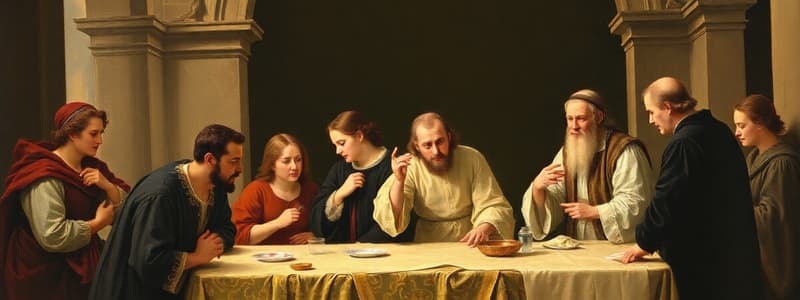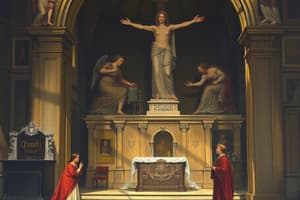Podcast
Questions and Answers
What was the primary reason for the Catholic Church's decision to initiate the Counter-Reformation?
What was the primary reason for the Catholic Church's decision to initiate the Counter-Reformation?
- To establish new colonies in the Americas and spread Catholicism to new populations.
- To promote scientific discoveries and integrate them into religious teachings.
- To fund the construction of grand cathedrals and expand its architectural legacy.
- To counteract the growing influence of Protestantism and retain followers. (correct)
Prior to Martin Luther's actions, what best describes the religious landscape of Western Europe?
Prior to Martin Luther's actions, what best describes the religious landscape of Western Europe?
- An even split between Catholicism in the south and Protestantism in the north.
- A predominantly Catholic region with few dissenting religious voices. (correct)
- A diverse mix of religious beliefs with significant regional variations.
- A collection of independent city-states each with its own unique religion.
In what way did the religious landscape of Europe shift in the years following Martin Luther's actions?
In what way did the religious landscape of Europe shift in the years following Martin Luther's actions?
- Northern and northwestern Europe became largely Protestant, while southern Europe remained mostly Catholic. (correct)
- The entire continent converted to various forms of Protestantism.
- Europe saw a resurgence of pagan beliefs and a decline in Christianity.
- Europe became religiously unified under a reformed Catholic Church.
Who is credited with initiating the Catholic Reformation?
Who is credited with initiating the Catholic Reformation?
What was the alternative name for the Catholic Reformation?
What was the alternative name for the Catholic Reformation?
Flashcards
The Reformation
The Reformation
A religious reform movement that gained strength in the 1500s leading many to leave the Catholic Church.
Catholicism
Catholicism
Before the Reformation, western Europe was mainly united under this single religion.
Northern and Northwestern Europe
Northern and Northwestern Europe
Regions in Europe that became centers for Lutheran, Calvinist, and other Protestant believers after the Reformation.
Catholic Reformation (Counter-Reformation)
Catholic Reformation (Counter-Reformation)
Signup and view all the flashcards
Pope Paul III
Pope Paul III
Signup and view all the flashcards
Study Notes
- The Reformation dramatically altered Europe starting in the early 1500s.
- Many left the Catholic Church to follow Protestant reformers
- Before Luther's Ninety-Five Theses, Catholicism was the main religion in western Europe.
- After Luther, northern and northwestern Europe became mainly Lutheran, Calvinist and other Protestsant believers.
- Southern Europeans particularly in Spain, France and Italy, remained primarily Catholic.
- By the 1530s, Europe had become deeply divided by religion.
- As Protestantism grew, the Catholic Church realized they needed to act.
- The Catholic Church’s response to the Reformation is called the Catholic Reformation, or the Counter-Reformation.
- The Counter-Reformation opposed the Protestant Reformation.
- Pope Paul III initiated the Catholic Reformation, with several popes continuing the movement.
Studying That Suits You
Use AI to generate personalized quizzes and flashcards to suit your learning preferences.




